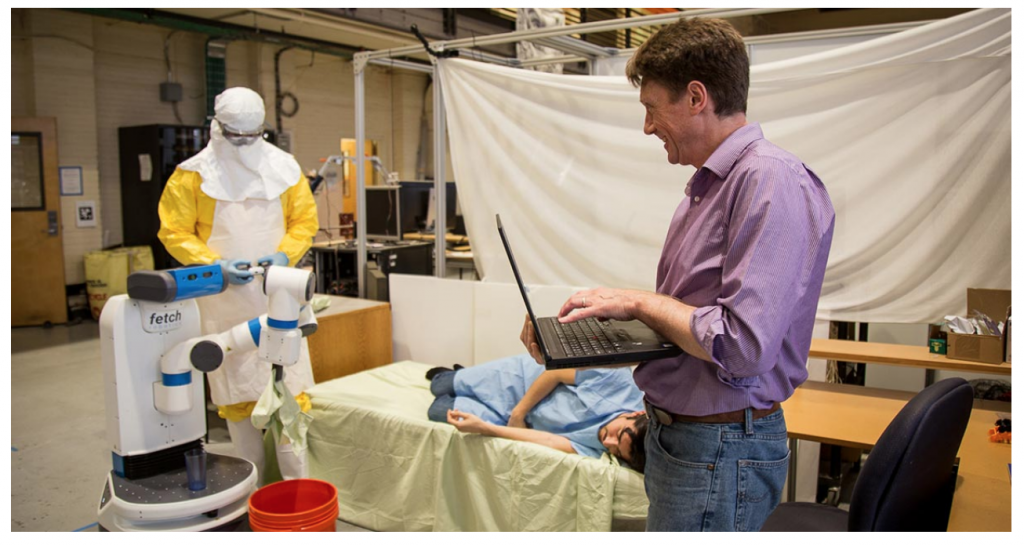
Graduate students Austin Whitesell and Alan Sanchez and Bill Smart, professor of robotics, demonstrate an experiment simulating how robots might be used during Ebola outbreaks. Photo by Oregon State University
Bots For Patient Care And UV Light Room Disinfecting Bots
In the collective worldwide struggle against the COVID-19 virus, some of the more positive news to come out of Italy and other COVID hot spots is the use of robotics to assist the workers on the medical frontline. The teams at PBS and writers at pbs.com have shone a light this week on how robots made a huge difference in this crisis.
“Automated devices have delivered meals to quarantined travelers in a Chinese hotel; enforced curfews in Tunisia; scanned visitors for fevers entering a South Korean hospital; monitored patients in a hard-hit Italian city; and tracked social distancing compliance from the skies in a number of cities around the world, including Elizabeth, New Jersey.”
The obvious advantage of using robots is their inability to become infected with the disease. They can go into quarantine areas without fear, unlike humans. Though they aren’t at the level “Westworld”-style robots being able to appear human, they have broad uses. Texas A&M University professor Robin Murphy, who studies how robots can be deployed during disasters, said “They are being used 24/7 and adapted to fit the needs of those using them.” “In a disaster, you don’t add completely new things. It takes years to build reliable systems.”
Since it takes years to produce these robots, it’s vital that governments, especially the United States, operate and finance programs that will protect its citizens better than in this outbreak. Murphy and her colleagues are tracking how drones and ground-based robots have been deployed during the coronavirus outbreak.
“The most common uses we’re seeing right now are in public safety, quarantine enforcement, and disinfecting of hospitals,” Murphy said.
Robots are sure to continue to make strides into dangerous jobs. However, integrating robots and other new technologies into existing health care workflows can present significant hurdles. That’s an issue Oregon State University robotics professor Bill Smart has been studying.
“If you go into a hospital, the nurses, doctors, even housekeeping, have a routine that they’re very comfortable with,” said Smart. “If I put something you’re not familiar with into that environment, into that workflow, then the chances of something going wrong are high. And if something goes wrong, someone could die. …I think the trick with robots, with any technology, is picking your battles. Robots aren’t good at everything. It’s figuring out what they are good at and getting that in there without disrupting the workflow.”
The article reveals two ways robots are being used in patient care and disinfecting areas in hospitals and points out they were successfully used in the 2014 Ebola outbreak. These products are not cheap to make and that has been one of the drawbacks keeping the medical field from using them more often.
Xenex’s LightStrike Germ-Zapping Robots, which cost roughly $125,000 per robot and last about five years, use high-powered bursts of broad-spectrum UV light to damage the genetic material in pathogens without damaging the surrounding environment and equipment.
The LightStrike is currently deployed in more than 500 health care facilities worldwide, including the Mayo Clinic, 70 Veterans Health Administration hospitals, and 10 Department of Defense hospitals. Last week, the company announced the LightStrike was recently tested on live SARS-CoV-2 virus at the Texas Biomedical Research Institute, as opposed to surrogate viruses that have been approved by the FDA for disinfection purposes. According to a company press release, the robot destroyed the virus in two minutes.
read more at pbs.org







Leave A Comment